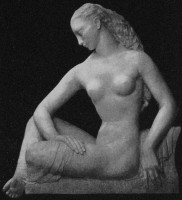 Typical allegorical statue of Meditation.
Typical allegorical statue of Meditation.
 Typical allegorical statue of Meditation.
Typical allegorical statue of Meditation.
M is for Meditation, and the thinking pose is one of appeal to the sculptor. Of course meditation is more than thought, more considered, more contemplative. Statues of Meditation are generally nude figures, without a need to hold anything, because the allegory should all be caught in the expression and gaze, the pose of the head, and the hand. The example above is typical – Meditation is shown seated on a treestump, head resting on her hand, her other hand clasping her knee. Her head is on one side – for when we meditate we do not look straight ahead – even a brief thought is always ‘somewhere over there’, and our gaze and neck turn to some imaginary spot.
Here are two views of another typical allegorical figure of Meditation, standing this time, again with hand on the chin, fingers wandering towards the mouth, the other hand this time on the head, not scratching it, but we may imagine little distracted movements and unconscious stroking of the hair to aid the thought. Although upright, the figure is in relaxed pose, for Meditation does not fit with active movement.
The half kneeling nude above left, though unusual in pose, again has the focus on the head, turned to one side, gaze downwards, eyes more closed than open, hand on the chin and hand on the head, so is in these respects a typical figure of Meditation. The girl above right, also with the gaze to one side, and entitled Meditation, might equally have been entitled 'Hesitation', as there is some movement in the figure. Both of these girls, like those above, are young, and this seems to be a characteristic of allegorical figures of Meditation – perhaps they have more to meditate about – their future lives, their loves, their destinies, while the older people have had their deeper thoughts and need to think only briefly to confirm or modify their previous thinking.
I wanted to include one clothed statue of Meditation, and recalled this bust, which is interesting in that there can be no helpful hand on the chin or lips or head to aid the allegory. But the downcast, sideways gaze, the tilt of the head, and the sombreness of the expression about the mouth capture the mood of Meditation excellently. The stillness of the figure, too, is indicated by the relaxed and tension-free folds of her scarf.
Finally, there is the idea that an allegorical sculpture of Thought is very similar to Meditation, and perhaps Contemplation too, though the latter usually has some visible object to contemplate. Here, then, is an example of each. The figure of Thought below left, another young, nude girl with head turned sideways, gaze down, elbows crooked, and motionless, though in a rather more modern idiom than the examples above, could indeed pass muster as an allegory of Meditation. I chose the example of Contemplation below right to have at least one masculine example. Here there does seem to be a significant difference from Meditation – while he looks to one side and downwards, he has some small fruit or stone to contemplate, and though perhaps pausing, there is enough flex in the body, tenseness in the muscles, and rising of the arch of the foot that this can be no figure at rest. The well-known figure of The Spirit of Contemplation, though, by Albert Toft, is different again, contemplating the middle distance rather than anything else, but, unlikely for a Meditation figure, looking straight ahead.

 Examples of Thought and Contemplation allegorical figures.
Examples of Thought and Contemplation allegorical figures.
Also in this series is a small group of not unrelated allegory in the person of Reverie.
Back to Allegorical sculpture - L // Onward to Allegorical sculpture - N // Full Alphabet of Allegorical sculpture
Sculpture in London // Sculpture in England // Sculptors
Visits to this page from 3 Oct 2013: 5,765